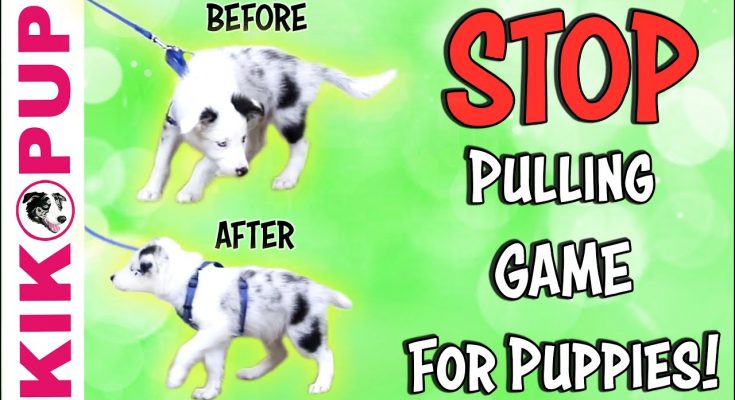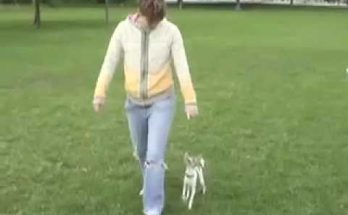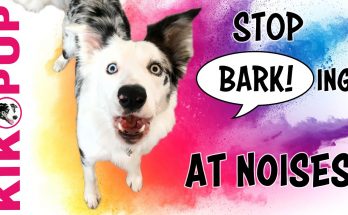Is your puppy pulling? Teach the Leash Pressure GAME!
If there were one exercise I think every puppy and dog should learn if they have to abide by leash laws, it is this one. If you want to know why some people struggle with a dog who pulls on leash, besides the issue of over-arousal, it is because they haven’t yet trained and proofed this behavior.
The giving into leash pressure game teaches your puppy what to do when he hits the end of the leash, which is to turn around and come back to you. By training and conditioning leash pressure in small enough approximations it is possible to turn what is usually a frustrating and aversive experience into a cue that has a positive association to the dog that simply means “move with me”. A lot of people believe certain stimuli are “intrinsically” reinforcing or punishing. But this is simply untrue. It is possible through training and conditioning to change an animal’s emotional response to a certain stimuli. Instead of just relying on habituation, where dogs learn over repetition that being moved by you on leash isn’t terrible I suggest playing these training games to make it an experience where the dog doesn’t feel like it’s some sort of intimidation game. I also suggest doing the same with teaching a dog to be picked up as well as handled and groomed.
Video tutorials mentioned:
Attention Game- https://www.youtube.com/watch?v=HiziN7mluz8
Recall- https://www.youtube.com/watch?v=rjd99MlmqqI
Leash walking reinforcing for standing next to you – https://www.youtube.com/watch?v=voW2Vkq0u6Q
Direction changes- https://www.youtube.com/watch?v=Eo-L2qtD7MQ
Step 1
Add light pressure on the leash as you lure your puppy forward and then feed a treat.
Step 2
Put a distraction down on the ground that makes the puppy pull on leash. Use your attention noise or treat lure to get your puppy to turn around and come back to you.
2 Use a lower value treat as the distraction and a higher value treat as the reinforcer.
Step 3
Put a distraction down on the ground that makes the puppy pull on leash. When the puppy is on a tight leash, move in the opposite direction of the puppy without jerking him. Mark and reinforce when you see your puppy turn in your direction. If the puppy doesn't turn toward you within 2 seconds, use your attention noise or treat lure to get your puppy to turn around and come back to you.
Step 4
Practice with different distractions in different situations
What to do if your puppy doesn't turn around:
1 Practice from further away from the distraction (You can have a helper put down the distraction to make this easier.)
If you're doing the exercise correctly, you will find that your puppy will stop pulling all together. This is a good thing! If he keeps trying to go for the distraction it means the distraction is too difficult, too close or you need to spend more time marking and reinforcing him for staying with you after he comes back. In real life situations if your puppy starts pulling on leash you can simply back up until he is on a loose leash then wait a little bit until you have made a connection with him again before walking forward.
This video is dedicated to one of the #1 Kikopup Sponsors:
Lee Gordon
Thank you to Lee and all my Kikopup members for making these videos possible!
Thanks for watching! Please give a thumbs up, comment and subscribe! It means a lot to me 🙂
Check out my dogs’ daily antics on INSTAGRAM: https://www.instagram.com/kikopup/
FOLLOW ON FACEBOOK: https://www.facebook.com/dogmantics/
CHECK OUT MY WEBSITE FOR FREE TRAINING ARTICLES, VIDEOS AND PRODUCTS: https://dogmantics.com/ The online store where you can find Professional Dog Training memberships, Self-study courses and video on demand for purchase: https://dogmantics.com/shop/
If you would like to support my work to create more educational videos like this one on how to train dogs without the use of physical or psychological intimidation, consider clicking the join button and becoming a member of channel Kikopup! It's kind of like the youtube version of patreon with perks. 🙂 Click this link here if a join button does not show up on your device such as a phone: https://www.youtube.com/user/kikopup/join
Happy Training! – Emily Larlham (AKA Kikopup)
#dogtraining #professionaldogtraining #puppytraining





Thank you so much for all your videos. This is exactly the video I needed!
You are very welcome 🙂
This is GOLD. I believe every dog owner should learn how to handle the leash without creating conflict.
Can’t tell you how much I love this ! Teaching leash pressure has yet to fail me for fixing pulling. It always works for me, any collar/harness combination.
Awe thanks Tesla. I included the first step being lure and add pressure at the same time, in the same way when working with handling touch and feed at the same time, because a lot of pet dog owners might not see the signs the puppy is uncomfortable if you were simply to add the pressure first and then feed a treat after… sometimes that is too much for the dog, so this was my most fool proof method for a youtube video. Honestly I struggled for weeks to think of the wording and how to stay it that would stop a puppy from having a negative experience during this game. I hope it helps a lot of puppies and helps blossom a lot of human and animal relationships 🙂
@Dog Training by Kikopup I’ve had a couple of clients who’s dogs would lose it with even slight leash pressure and struggled, that extra step you described is genius and will be going straight into my routine. Thank you again, for being doing what you do and inspiring me for so many years.
@Tesla Nick Awe thanks.
My puppy is struggling with pulling on leash especially if she sees people or other dogs. We’re working on it step by step and you made this video just in time to speed everything up, thank you!
there is another game to play if you email me at dogmanticsstore@gmail.com But also importantly, if you teach your dog to be calm around people and dogs then the pulling goes away. So doing exercises like settling on a mat around people and dogs will help a lot 🙂
I struggle with the same issue around other people and dogs. If they come closer than my pups threshold, all his good manners that we have trained go out the window. I would love to learn some games to help with this. At a certain distance he is great at settling and staying calm but there are situations where the distance can’t be controlled
This is EXACTLY what I needed to see. Thank you!
Oh you are welcome!
You are an amazing teacher for dogs and people!!!!!
Thanks that means a lot.
Kiko is a goddess.
Thanks for this remake! Really excellent.
This is such an important topic.
Besides Chrissi Schranz you are the only dogtrainer
who propagates this technique.
This game has helped us a lot.
I have no idea WHY people dont see the value in it… I learned it from my mentor gosh over 16 years ago… I have no idea why its taking people so long to cotton on…
Wonderful clear easy to follow games/exercises that yields fantastic results everytime. Thanks for sharing you knowledge & experience. Your time dedication, commitment & enthusiastic approach are very much appreciated. Thank you so much.
Thanks also Lee Gordon & all of the supporting members for helping keep this channel possible. Without you all I suspect this channel would be difficult to sustain. Countless dogs worldwide are benefiting directly as a result of Emily’s teaching. Educating & spreading positive training behaviours in a way only Emily knows how. Helping us all understand our dogs much much better. I feel this is particularly important in times of crisis when dogs often get neglected. Thank you everyone. Much love to all.
Yes indeed. The memberships program is making it so I can focus on my youtube channel to get the information out there for the general public 🙂 Thanks!!!!
@Dog Training by Kikopup Thanks so much Emily. Your work makes such a difference & is very much appreciated. Thanks.
Hi, we have a 13 month old fox red lab (entire male). He had surgery on both front legs for elbow dysplasia when he was 5 months old. One leg still gives him bother from time to time. He pulls really really hard on his harness, collar, gen con – it doesn’t matter what we try on him he still pulls with great strength. In turn, this pushes down through his elbow and he quite often ends up needing prescribed pain relief. I feel that if we could teach him loose leash walking this would help his leg greatly and of course make walking him much more enjoyable. Could you please advise which download we would be best to buy/download. Thank you very much.
This exercise will of course be of great help. I have a video with an adult dog doing the exercise. https://www.youtube.com/watch?v=Q4vEayrRyB0 As for courses I have a 6 week self study course on leash walking https://dogmantics.com/product/leash-walking-connected/ 1 Thing to do is to walk back and forth instead of in a circuit as this will cut down on the excitement to move forward as the dog will have checked out the areas already. I suggest first starting out by walking back and forth 10-20 feet and then expanding how far you walk as your dog relaxes. Another thing you can do is get your dog to settle on a mat, walk away from the mat and then return and work on the settling behavior.
@Dog Training by Kikopup Thank you so much for your reply. Very much appreciated 🙂
This is so helpful. My puppy would ignore me 100% of the time when we go outside. He gets too entirely distracted by just about everything and gets too overly excited when he sees other people.
Thank you for your excellent training videos! I am doing a ton of puppy research before getting my first dog at the end of the year – your videos break everything down so nicely. Can’t wait to try your methods out 😊
All your videos are fantastic, Emily (as everyone’s told you you’re a great teacher), but this one I really have to try. My pup is crazy about sniffing when we walk around and just reinforcing walking next to me doesn’t seem to be working.
I’m binge watching your videos. Thank you for everything ❤️❤️
Oh you are very welcome! 🙂
I’m writing a comment to support your excellent channel. Your efforts are greatly appreciated!!
I’m already learning even though I’ll get a puppy next year 🙂 It’s so much better to be prepared, it makes me feel caring and loving even before getting the puppy. Training it’s a form of respect!
I’m glad to have become aware of your channel. There are many new nouances of dog training to be found here. Thanks!
Thank you for this video! We are training our Bichon Frise pup, Luna. She is an excellent dog who wants to please, but we are just learning to be dog parents. These videos are so helpful! But, it turns out Luna is easier to train than my husband. 🙂 I’m hoping I truly understood what you mean by the dog will “generalize the behavior” and that Luna will be as obedient with hubby as she is with me. But, first I have to get hubby to use the same commands I use. He uses “no” and “stop it” for everything, but Luna understands “No” as a general corrections. She also understands “with me” (heel) “wait” (stay) and “off” (four on the floor), so it’s confusing for her to be told “no” when he really just wants her not to jump on his lap, which she would understand if he said “off.” I’m bell training her for going out to potty. While I work from home, I get distracted and ignore her cues (not on purpose; I’m just working) and I want to give her a simple way to let me know it’s serious. She’s so trainable! Now I just need to get hubby to follow through with what I’m doing.
My 13 week old lab puppy gets over excited with the treat aspect of training. She jumps and twists sometimes when she sees me reaching for the treats and will not walk by my side calmly. Sometimes if i try to go without treats she just sits and refuses to walk. Any suggestions?
Thank you so much! I have been looking for these kind of training exercises that are solid and on point.
My puppy is 16 months old and this exercise has helped us so much in just a few days. After three group training sessions and a few one on one this has been the most effective. Wish I had found it earlier, but that’s ok, we’ll work it out now.
You know? Puppies dont remember what they learned as puppies… the same as we dont remember when we met our aunt sally on some trip etc… Some of that info gets tossed out in the trash… So most people have to do brush up training in adulthood for stuff like leash pulling. Also their motivations are so different as a puppy and as an adult its like a different dog… So you would have had to do brush up lessons anyway 🙂 So dont fret. You got this! 🙂
As much as I wish I had sent my dog to Brandon for training before bringing him home https://www.youtube.com/post/Ugkx1_veP7CApJK_GWy_TczaMciuG64PqJeU I am so grateful for this down-to-earth, practical guide. His training techniques and tips really work. Thank you as well for dedicating your life’s work to rescue dogs, and to rescuing those of us who want the very best for our 4-legged family members.
I have a 40kg mastiff rescue who is very reactive. Picking him up is not an option and he’s more than capable of putting me on the deck if he pulls and I’m not expecting it. Going to work on this. It’s very similar to training techniques I’ve used with young ponies and horses.
Yes keep conditioning this, and when pulling starts to come back do more sessions of it. You can set up distractions in your home and yard first before doing it out and about